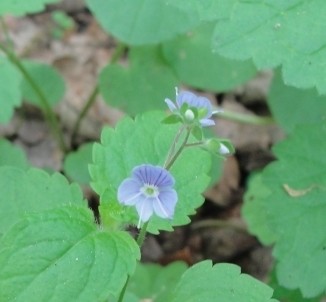Wood speedwell
(Veronica austriaca austriaca)

Description
Veronica montana or wood speedwell is a perennial species of flowering plant from the genus Veronica. It also belongs to the family Plantaginaceae. Veronica montana is a perennial plant growing up to 20 cm in height. It has a sprawling growth habitat, which helps it spread across the forest floor. The plants stems are covered in tiny, soft glandular hairs. Stems can produce roots when contact with damp soil is made. The leaves are ovate, toothed and are also covered in hairs. They appear in symmetrical pairs along the plants stem. The plant hosts multiple lilac coloured flowers from late spring to early summer. Flowers are tiny at around 7mm across. The species native range is from Europe to Western Transcaucasus, Northwestern Africa. The following ranges are indicated: Albania, Algeria, Austria, Baltic States, Belarus, Belgium, Bulgaria, Corsica, Czechoslovakia, Denmark, France, Germany, Great Britain, Greece, Hungary, Ireland, Italy, Netherlands, North Caucasus, Poland, Portugal, Romania, Sicily, Spain, Sweden, Switzerland, South Caucasus, Tunisia, Turkey, Ukraine, Yugoslavia. Wood speedwell is commonly associated with long-established, damp deciduous woodland, where it is generally found in lowland habitats. V. montana is also known to inhabit areas with neutral to mildly acidic soils. Another habitat it can be found is within shaded hedgerows where it can also find its way into gardens. This species can grow within a wide range of substrates from loam, heavy clay and sandy soils. Veronica is the largest genus in the flowering plant family Plantaginaceae, with about 500 species; it was formerly classified in the family Scrophulariaceae. Common names include speedwell, bird's eye, and gypsyweed. Taxonomy for this genus is currently being reanalysed, with the genus Hebe and the related Australasian genera Derwentia, Detzneria, Chionohebe, Heliohebe, Leonohebe and Parahebe now included by many botanists. Monophyly of the genus is supported by nuclear ribosomal internal transcribed spacer (ITS) and cpDNA. The taxa of the genus are herbaceous annuals or perennials, and also subshrubs, shrubs or small trees if Hebe is included. Most of the species are from the temperate Northern Hemisphere, though with some species from the Southern Hemisphere; Hebe is mostly from New Zealand.
Taxonomic tree:







